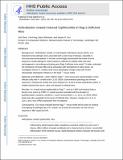| dc.contributor.author | Shen, Zeli | |
| dc.contributor.author | Feng, Yan | |
| dc.contributor.author | Rickman, Barry H | |
| dc.contributor.author | Fox, James G | |
| dc.date.accessioned | 2017-05-31T15:41:26Z | |
| dc.date.available | 2017-05-31T15:41:26Z | |
| dc.date.issued | 2015-03 | |
| dc.identifier.issn | 1083-4389 | |
| dc.identifier.issn | 1523-5378 | |
| dc.identifier.uri | http://hdl.handle.net/1721.1/109464 | |
| dc.description.abstract | Background
Helicobacter cinaedi, an enterohepatic helicobacter species (EHS), is an important human pathogen and is associated with a wide range of diseases, especially in immunocompromised patients. It has been convincingly demonstrated that innate immune response to certain pathogenic enteric bacteria is sufficient to initiate colitis and colon carcinogenesis in recombinase-activating gene (Rag)-2-deficient mice model. To better understand the mechanisms of human IBD and its association with development of colon cancer, we investigated whether H. cinaedi could induce pathological changes noted with murine enterohepatic helicobacter infections in the Rag2[superscript −/−] mouse model.
Materials and Methods
Sixty 129SvEv Rag2[superscript −/−] mice mouse were experimentally or sham infected orally with H. cinaedi strain CCUG 18818. Gastrointestinal pathology and immune responses in infected and control mice were analyzed at 3, 6 and 9 months postinfection (MPI). H. cinaedi colonized the cecum, colon, and stomach in infected mice.
Results
H. cinaedi induced typhlocolitis in Rag2[superscript −/−] mice by 3 MPI and intestinal lesions became more severe by 9 MPI. H. cinaedi was also associated with the elevation of proinflammatory cytokines, interferon-γ, tumor-necrosis factor-α, IL-1β, IL-10; iNOS mRNA levels were also upregulated in the cecum of infected mice. However, changes in IL-4, IL-6, Cox-2, and c-myc mRNA expressions were not detected.
Conclusions
Our results indicated that the Rag2[superscript −/−] mouse model will be useful to continue investigating the pathogenicity of H. cinaedi, and to study the association of host immune responses in IBD caused by EHS. | en_US |
| dc.description.sponsorship | United States. National Institutes of Health (R01-0D011141) | en_US |
| dc.description.sponsorship | United States. National Institutes of Health (R01-CA067529) | en_US |
| dc.description.sponsorship | United States. National Institutes of Health (P30-ES002109) | en_US |
| dc.description.sponsorship | United States. National Institutes of Health (P01-CA026731) | en_US |
| dc.language.iso | en_US | |
| dc.publisher | Wiley Blackwell | en_US |
| dc.relation.isversionof | http://dx.doi.org/10.1111/hel.12179 | en_US |
| dc.rights | Creative Commons Attribution-Noncommercial-Share Alike | en_US |
| dc.rights.uri | http://creativecommons.org/licenses/by-nc-sa/4.0/ | en_US |
| dc.source | PMC | en_US |
| dc.title | Helicobacter cinaedi Induced Typhlocolitis in Rag-2-Deficient Mice | en_US |
| dc.type | Article | en_US |
| dc.identifier.citation | Shen, Zeli; Feng, Yan; Rickman, Barry and Fox, James G. “ Helicobacter Cinaedi Induced Typhlocolitis in Rag-2-Deficient Mice .” Helicobacter 20, no. 2 (November 2014): 146–155 © 2014 John Wiley & Sons Ltd | en_US |
| dc.contributor.department | Massachusetts Institute of Technology. Division of Comparative Medicine | en_US |
| dc.contributor.mitauthor | Shen, Zeli | |
| dc.contributor.mitauthor | Feng, Yan | |
| dc.contributor.mitauthor | Rickman, Barry H | |
| dc.contributor.mitauthor | Fox, James G | |
| dc.relation.journal | Helicobacter | en_US |
| dc.eprint.version | Author's final manuscript | en_US |
| dc.type.uri | http://purl.org/eprint/type/JournalArticle | en_US |
| eprint.status | http://purl.org/eprint/status/PeerReviewed | en_US |
| dspace.orderedauthors | Shen, Zeli; Feng, Yan; Rickman, Barry; Fox, James G. | en_US |
| dspace.embargo.terms | N | en_US |
| dc.identifier.orcid | https://orcid.org/0000-0001-9307-6116 | |
| mit.license | OPEN_ACCESS_POLICY | en_US |
